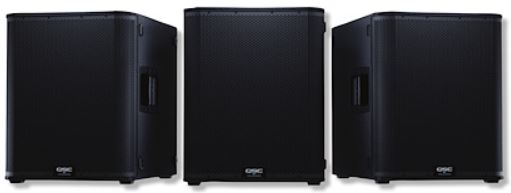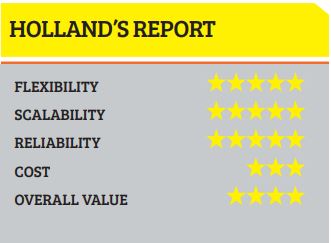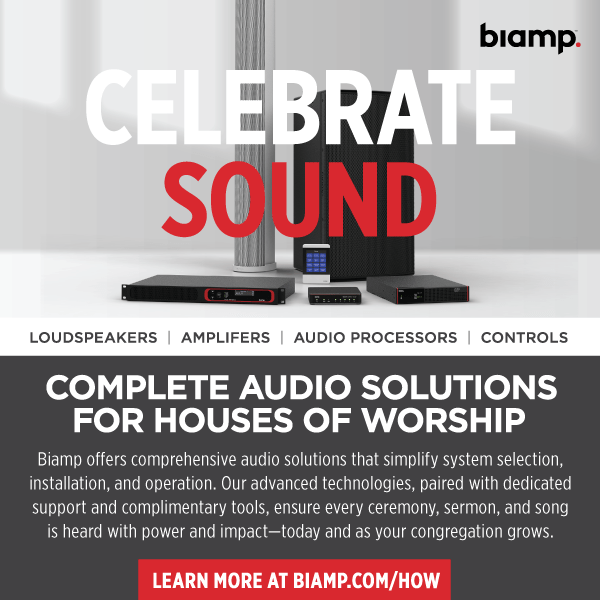
I am fortunate enough to live within driving distance of the QSC Factory and we are huge fans of their products. Not because they’re close and cost effective, but because they sound great and they
produce products that fits in a variety of applications for houses of worship. We recently moved into a sanctuary that seats 160 and we use the QSC K12.2 speakers for front of house and although they are adequate enough for the room, I was wanting a little more punch and presence in the low end. We do a lot “He Thunders with His Majestic Voice!” of events for musicians and recently had Dominique DiPiazza, Norm Stockton and Dave Owens do an incredible bass and drums demonstration for the musicians in our area and the need became obvious.
One of the problems I face with many subs is what I call the “woof ” factor. You plug in a sub and it adds more woof, which I’m told can be an EQ issue. However, when you start changing EQ for one thing then it causes a chain reaction with everything else. I didn’t experience that with the QSC KS 118 Subs. In fact, the word that best describes the sound is transparent. What that means to me is you couldfeel the fullness, you could feel the power, you could hear the extra punch… but you didn’t hear the SUB. It didn’t have the woof factor.
The KS118 is a frontloaded dual-ported cabinet with a single 18” speaker. I personally think you need a minimum of 18” to get a full rich bass response. The cabinet is a solid a 124.5 lbs. and I was thankful that the model we reviewed had wheels on them. You will need them. It’s constructed out of 18mm Birch Plywood and it just looks cool. We placed two subs on the ground on opposite sides of the stage for this review. The SUB is described as a very high output active subwoofer. It features an 18” (460 mm) long excursion direct radiating driver powered by a 3600 Watt Class D amplifier. It operates in two modes, omni-directional or cardioid radiation which requires two units to get the full benefit. It’s rated at a maximum SPLof 136 dB and peak at one meter (which is somewhere between an air raid siren and a jet engine at takeoff). The frequency range is 35 Hz – 111 Hz (-10 db) and the frequency response is 41 Hz – 98 Hz (-6 dB). That’s all the basic tech info like getting the length, weight and gender of a newborn baby.
Now let’s get into what really impressed me. First, it passed the people test. At the end of the day, it doesn’t matter how impressive the specs are. The bottom line is how they sound, anywhether or not people want to turn them down or turn them up. If they like what they hear, they want to turn them up. If they don’t like what they hear…you get the drift. The KS118 SUBS filled out the sound in the right places in a way that didn’t put pressure on your ears. When they were turned up,they didn’t sound like mud like many subs do. That allowed me to get volume with clarity and without sonic confusion. In a church setting where you’re mixing for a wide audience, the bass can cause a lot of problems for people with hearing issues. I loved the clear and transparent sound of the
KS118’s.
The second thing that impressed me was the cardioid configuration where you can set them as “rear” or “forward” – and you can definitely tell the difference. This is designed to work with two subs together. You can stack them, place them side by side or place them back to back. The key is to place one sub facing away from the audience and the other facing towards the audience. The one facing the audience you set forward, the other you set rear and what it creates is a cardioid pattern that “throws” the sound forward and lessens the sound 15 dB behind the speakers. That means the sound is where it needs to be and the band isn’t living in the woof zone. How they came up with this is pure genius and it sounds amazing. Even when you use the speakers alone, the rear and forward configurations add their own unique characteristics to the sound. When using as a standalone (one on each side of the stage), I actually preferred
the “rear” setting. In our venue it produced a pleasant fullness without the mud. You also have an option to turn the Deep mode on or off. When you select the Deep mode it extends the low-frequency below 60 Hz without reducing any available headroom. In our application, we preferred to turn the Deep Mode off. I also liked the simplicity of the crossover. You have basically an 80 Hz low-pass filer or a 100 Hz low-pass filter. The 80 Hz is optimized for the CP and K.2 Series (which we have) and it did sound the best in our application. The 100 Hz is optimized for the K, KLA and KW speakers.
 The third thing that impressed me was the power of these speakers. We ran them for consecutive church services with different settings over four weeks and had nothing but compliments for how great the sound was, without it being too loud or overpowering. We were able to achieve a fuller sound at what was perceived to be a lower volume, even though we were mixing a little louder than normal. When the people cleared the building, we pumped the sound and it was just as clean, clear and punchy at loud volumes with no noticeable distortion or harshness. We were advised we could get by without subs, but after experiencing the KS118’s I’m convinced they’re a game changer even for a smaller venue.
The third thing that impressed me was the power of these speakers. We ran them for consecutive church services with different settings over four weeks and had nothing but compliments for how great the sound was, without it being too loud or overpowering. We were able to achieve a fuller sound at what was perceived to be a lower volume, even though we were mixing a little louder than normal. When the people cleared the building, we pumped the sound and it was just as clean, clear and punchy at loud volumes with no noticeable distortion or harshness. We were advised we could get by without subs, but after experiencing the KS118’s I’m convinced they’re a game changer even for a smaller venue.
HOLLAND DAVID IS A TEACHING PASTOR, VETERAN WORSHIP LEADER, COMPOSER AND AUTHOR. HE IS THE SENIOR PASTOR OF CALVARY CHAPEL SAN CLEMENTE AND CEO OF WORSHIPSONG.COM YOU CAN FOLLOW HIM ON TWITTER OR INSTAGRAM @ HOLLANDDAVIS.





